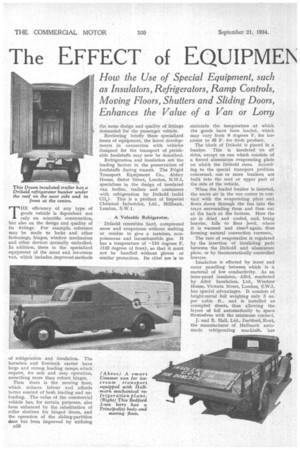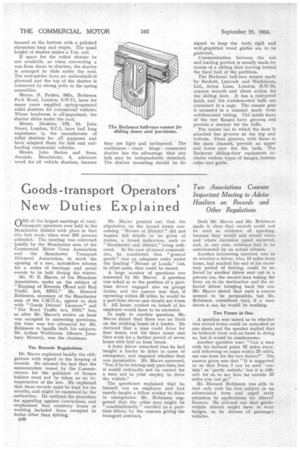The EFFECT of E LAMLE\ "F on VEHICLE EFFICIENCY
Page 86

Page 87

Page 88

If you've noticed an error in this article please click here to report it so we can fix it.
How the Use of Special Equipment, such as Insulators, Refrigerators, Ramp Controls, Moving Floors, Shutters and Sliding Doors, Enhances the Value of a Van or Lorry
TRR efficiency of any type of goods vehicle is dependent not only on scientific construction, biit also on the design and quality of its fittings. For example, reference may be made to locks and other fastenings, hinges, window mechanism and other devices normally embodied. In addition, there is the specialized equipment of the meat and ice-cream van, which includes, improved methods
of refrigeratiOn and insulation. The horsebox and livestock carrier have large and strong loading ramps, which require, for safe and easy operation, something more than robust hinges, Then there is the moving floor, which reduces labour and affords better control of both loading and unloading. The value of the commercial vehicle has, for certain purposes, also been enhanced by the substitution of roller shutters for hinged doors, and the operation of the sliding-partition door has been improved by utilizing o28 the same design and quality of fittings demanded for the passenger vehicle.
Reviewing briefly these specialized items of equipment, the latest developments in connection with vehicles designed for the transport of perishable foodstuffs may now be described,
Refrigeration and insulation are the leading factors in the preservation of foodstuffs during transit. The Frigid Transport Equipment Co., Abbey House Baker Street, London, N.W.1, specializes in the design of insulated van bodies, trailers and containers with refrigeration by Drikold (solid CO2). This is a product of Imperial Chemical Industries, Ltd., Milbank, London, S.W.1.
A Valuable Refrigerator.
Drikold resembles hard, compressed snow arid evaporates without melting or residue to give a tasteless, nonpoisonous and incombustible gas. It has a temperature of —110 degrees F. (142 degrees of frost), so that it must not be handled without gloves or similar protection. It chief use is to maintain the temperature at which the goods have been loaded, which may vary from 0 degrees F. for icecream to 45 F. for fresh produce.
The block of Drikold is placed in a bunker. This is insulated on all sides, except on one which consists of a finned aluminium evaporating plate on which the Drikold rests. .AccordMg to the special transport problem concerned, one or more bunkers are built into the roof or upper part of the side of the vehicle.
When the loaded bunker is inserted, the warm air in the van comes in contact with the evaporating plate and flows down through the fins into the trays surrounding them and then out at the back at the bottom. Here the air is dried and cooled, and, being heavier, falls to floor level, where it is warmed and rises 'l again, thus forming natural convection currents., The rate ot evaporation is regulated by the insertion of insulating pads between the Drikold and aluminium plate, or by thermostatically controlled louvres.
Insulation is effected by inner, and outer panelling between which is a material of low conductivity. As an inter-panel insulator, Alfol, marketed by Alfol Insulation, Ltd., Windsor House, Victoria Street, London, S.W.1, has special advantages. It consists of bright-metal foil weighing only 3 oz. per cubic ft., and is installed as crumpled sheets, thus allowing the layers of foil automatically to space themselves with the minimum contact.
J. and E. Hall, Ltd., Dartford, Kent, the manufacturer of Hallmark automatic refrigerating machinea, has specialized for over 40 years in this branch of engineering. An interesting example of its activity is the large icecream van divided, by an insulated ' partition, into two air-tight compartments, each with its own door. There is also an uninsulated compartment for empties and another for the compactly arranged refrigerating plant.
The van is loaded with ice cream, during the late afternoon, and deliveries start -the following morning.
During the intervening period the correct temperature is maintained by the automatic operation of the plant, as it is during the day, when the doors have to be opened frequently in order to make deliveries.
The Monarch control, made by the Monarch Door Controller Co., Ltd., 7, Victoria Street, London, S.W.1, is designed for the easy operation of the ramps of horseboxes and livestock vehicles. As a ramp may weigh 400 lb., it is necessary that it should be counterbalanced.
Each pair of Monarch controls is assembled to suit the particular vehicle concerned. This ensures that the ramp is properly balanced and comes to rest in the open position without any tendency to rise unaided. Two patterns are made, the chief variation being in the method of securing the actuating springs.
A throw crank is pivoted to a bracket on the lower part of the ramp, which actuates bell-crank and link motions under the van, whereby the spring is either compressed or released. With one scheme, the Spring and its 'centre rod are mounted inside the chassis. In the. other, they are below the chassis. A more, recent pattern allows the springs to be mounted between a pair of .brackets bolted to the cross-bearer and independent of the chassis.
The Easilift ramp spring, made by William E. Cary, Ltd., Red Bank, Manchester, 4, is of steel, 2+ ins. Wide, with two, three or four U-shaped leaves, accordingto the weight of the ramp. The lower end is horizontal and bOlted under the body, and the upper end is designed to bear and slide against a guide plate on the ramp. This ramp spring is easily fitted and is removed by releasing two bolts. As may be recalled, it was incorporated in a Jennings cattle truck exhibited at the Royal Show this year.
Advantages of Moving Floors.
The movable-floor vehicle is equipped with a belt-conveyer system, which is easily controlled in order that the load may be wholly or partly discharged. Moreover, if the load be fragile, the floor may be utilized to bring the bags or cases to the rear for lifting. By reversing its operation, the floor is used for loading. By keeping the lorry moving, road metal, manure, etc., may be spread.
The Principality moving froor, produced by the Principality Wagon Co., Ltd., Cardiff, consists of a lubber and cotton duck floor belt clamped on a geared wood roller at each end. The belt is supported on a frame of three rows of steel tubes, which are mounted on ball races. The movable floor may also be mounted for side discharge.
The Transport moving floor, which is operated by the engine, forms part of the all-metal bodywork made by Transport Engineering, Ltd., 5(41, Old Kent Road, London, S.E.I. The floor is made up of half-round lead-coated steel slats pressed over a hardwood insert.
The slats are linked together in such a manner that the heavier the load the tighter becomes the joint. The floor is mounted on three endless Renold chains which are driven by sprockets mounted on front and rear cross-shafts. The front shaft has an additional sprocket which is driven from a dogengagement gearbox below it. This box, which is controlled by a lever in the cab, takes its drive from a shaft extending from the main gearbox.
A special feature of the Transport equipment is an oblique bulkhead which travels with the floor, not only pushing the load to the rear, but also ensuring a clean discharge. With refuse collector, -the bulkhead is utilized to compress the load.
'A notable feature of present-day vans of all descriptions is the wide employment of roller shutters.
.LightneSs and compactness are claimed for the shutters made by G. Brady ancl.Co.; Ancoats, Manchester, 4. The shutter is attached to a spring assembly at each side and works in guides having a a-in. groove. It is
-secured at the bottom with a polished chromium hasp and staple. The usual height of shutter makes a 7-in. coil.
If space for the coiled shutter be not available, as when converting a van from doors to shutters, the shutter is arranged to slide under the roof. The roof-guides have an undershield of plywood and the top of the shutter is connected by strong webs to the spring assemblies.
Messrs. IL Parker, 341a, Battersea Park Road, London, S.W.11, have for many years supplied spring-operated roller shutters for commercial vehicles. Where headroom is all-important, the shutter slides under the roof.
Messrs. Haskins, 159, St. John Street, London, E.C.1, have had long experience ia the manufacture of roller shutters for all purposes and have adapted them for side and endloading commercial vehicles.
Messrs. T oh n Barker and Sons, Ancoats, kanchester, 4, advocate wood for all vehicle shutters, because
they are light and rattleproof. The continuous chain hinge connected shutter has the advantage that any lath may be independently detached. The shutter mounting should be de signed to keep the body rigid and well-graphited wood guides are to be preferred.
Communication between the cab and loading portion is usually made by means of a sliding door moving behind the fixed half of the partition.
The Beclawat ball-race runner made by Beckett, Laycock and Watkinson, Ltd., Acton Lane, London, N.W.10, ensures smooth and silent action for the sliding door. It has a rust-proof finish and the stainless-steel balls are contained in a cage. The runner gear is mounted in a channel,. made from weldless-steel tubing. The inside faces of the two flanges have grooves and provide a runway for the balls. The runner bar to which the door is attached has grooves at the top and bottom. These grooves, with those in the main channel, provide an upper and lower race for the balls. The Beclawat sliding-door equipment includes various types of hanger, bottom roller and guide.








































































































































































